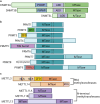Intrafamily heterooligomerization as an emerging mechanism of methyltransferase regulation
- PMID: 38429855
- PMCID: PMC10908127
- DOI: 10.1186/s13072-024-00530-0
Intrafamily heterooligomerization as an emerging mechanism of methyltransferase regulation
Abstract
Protein and nucleic acid methylation are important biochemical modifications. In addition to their well-established roles in gene regulation, they also regulate cell signaling, metabolism, and translation. Despite this high biological relevance, little is known about the general regulation of methyltransferase function. Methyltransferases are divided into superfamilies based on structural similarities and further classified into smaller families based on sequence/domain/target similarity. While members within superfamilies differ in substrate specificity, their structurally similar active sites indicate a potential for shared modes of regulation. Growing evidence from one superfamily suggests a common regulatory mode may be through heterooligomerization with other family members. Here, we describe examples of methyltransferase regulation through intrafamily heterooligomerization and discuss how this can be exploited for therapeutic use.
Keywords: Methylation; Methyltransferase; Oligomerization; Regulation.
© 2024. The Author(s).
Conflict of interest statement
The authors declare that they have no competing interests.
Figures



Similar articles
-
Molecular Basis for Autocatalytic Backbone N-Methylation in RiPP Natural Product Biosynthesis.ACS Chem Biol. 2018 Oct 19;13(10):2989-2999. doi: 10.1021/acschembio.8b00668. Epub 2018 Sep 25. ACS Chem Biol. 2018. PMID: 30204409 Free PMC article.
-
An Ash2L/RbBP5 heterodimer stimulates the MLL1 methyltransferase activity through coordinated substrate interactions with the MLL1 SET domain.PLoS One. 2010 Nov 23;5(11):e14102. doi: 10.1371/journal.pone.0014102. PLoS One. 2010. PMID: 21124902 Free PMC article.
-
Structural and biochemical insights into 2'-O-methylation at the 3'-terminal nucleotide of RNA by Hen1.Proc Natl Acad Sci U S A. 2009 Oct 20;106(42):17699-704. doi: 10.1073/pnas.0907540106. Epub 2009 Oct 12. Proc Natl Acad Sci U S A. 2009. PMID: 19822745 Free PMC article.
-
Structure and function of DNA methyltransferases.Annu Rev Biophys Biomol Struct. 1995;24:293-318. doi: 10.1146/annurev.bb.24.060195.001453. Annu Rev Biophys Biomol Struct. 1995. PMID: 7663118 Review.
-
Protein lysine methylation by seven-β-strand methyltransferases.Biochem J. 2016 Jul 15;473(14):1995-2009. doi: 10.1042/BCJ20160117. Biochem J. 2016. PMID: 27407169 Review.
Cited by
-
Oligomerization of protein arginine methyltransferase 1 and its effect on methyltransferase activity and substrate specificity.Protein Sci. 2024 Aug;33(8):e5118. doi: 10.1002/pro.5118. Protein Sci. 2024. PMID: 39022984 Free PMC article.
References
Publication types
MeSH terms
Substances
Grants and funding
LinkOut - more resources
Full Text Sources

